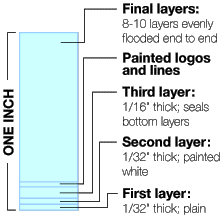The Ice
Making an ice rink isn't as simple as flooding the floor with gallons of water. The crew must apply the water carefully and slowly, in order to insure ideal thickness. An ice surface that is too thick requires more energy to keep frozen and is prone to getting soft on the top. A surface that is too thin is also dangerous because skaters risk cutting straight through the ice.
It takes between 12,000 and 15,000 gallons (45,000 to 57,000 L) to form a Hockey rink surface. The maintenance crew forms the ice in several different layers, in many steps:
Advertisement
- The crew sprays the first two layers on using a paint truck. The paint truck creates a fine mist of water to create the first two layers, each only 1/30 of an inch thick. The first layer freezes almost immediately after it is sprayed on.
- Once the first layer is frozen, the crew sprays on the second layer.
- The crew paints the frozen second layer white with the paint truck, allowing for a strong contrast between the black hockey puck and the ice.
- The crew then sprays on the third layer. This layer, which is only one-sixteenth of an inch thick, acts as a sealer for the white paint. The crew paints the hockey markings (the lines, creases, face-off spots and circles) and team and sponsor logos on top of this third layer.
- Once the markings and logos dry, the crew gradually applies the final layer.
The crew slowly applies the remaining 10,000 gallons with a flooding hose. "We put on 500 to 600 gallons per hour until the remaining layer is complete," says MacMillan. "That means 15 to 20 hours (1 hour/500-600 gallons) for that final layer. Each of those layers is allowed to freeze before we put the next 500 to 600 gallons on. The less water you put on the floor at one time, the better your ice will be."
Temperature: Good Ice vs. Bad Ice
When creating a new ice surface, indoor conditions are very important. MacMillan says he likes to "keep the skating surface at 24 to 26 F (about -4 C), the building temperature at about 63 F (17 C), and the indoor humidity at about 30 percent. But if it's warm outdoors and we have an event where the doors are open and all that warm air comes in, then we have to adjust it. Even one degree can make a big difference in the quality of the ice."
An indoor high humidity can create a fog over the ice. The Raleigh arena has more than 770,000 square feet, and requires 12 dehumidifiers throughout the building to keep the air dry indoors. The outdoor temperature can also affect the ice conditions. The arena and ice temperatures must change to compensate for the heat and humidity that will come in when the arena doors are opened to fans and spectators.
Many NHL players have expressed concerns about ice conditions in very warm-weather cities during the Stanley Cup playoffs. They fear the outdoor temperature may be hot enough to soften the ice inside the building. In Canada, the problem is just the opposite. The buildings often have to be heated because the extremely low temperatures outside can cause problems with the ice.
Ice conditions can vary greatly with a temperature change as small as one degree. The type of water also can change conditions. For example, ice made with water that contains dissolved alkaline salts may have a sticky feel to it and will dull skate blades. To counteract these problems, many rinks -- including the Raleigh arena -- use water purifiers or add chemical conditioners to tap water.
Figure skaters and hockey skaters have different ideas of what good ice and bad ice are. Figure skaters prefer an ice temperature of 26 to 28 F. Ice in that temperature range is softer, so it grips the skate edges better. It is also less likely to shatter under the impact of jumps. Hockey players, though, prefer colder, harder ice. With many skaters on the ice simultaneously, it's easy for the ice surface to get chewed up at the temperatures preferred by figure skaters. For hockey games, the top of the ice is usually kept at 24 to 26 F. Ice that's too warm might cause players to lose their edge during a crucial play, but ice that's too cold may chip too readily.
